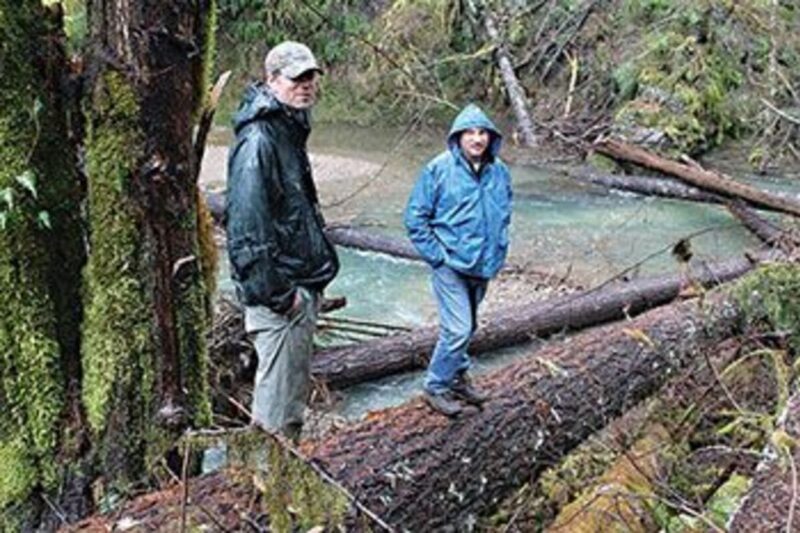Sean C. Morgan
Fish spawning bed restoration efforts have look of success in forest stream.
Winter steelhead seeking the conditions necessary to spawn may soon find the Soda Fork of the South Santiam River an inviting location as gravel continues to accumulate in the stream bed following efforts to create that habitat for the fish.
Last summer, much of the river ran across bare rock. The river had scoured away the gravel after fallen timber was removed from the stream in the past. Logs chained to the banks indicated previous efforts to restore spawning habitat, but they had failed to help much.
In August, the South Santiam Watershed Council, in cooperation with the U.S. Forest Service, dropped trees across the Soda Fork of the South Santiam River to start catching and holding gravel in the stream – among the first steps in the Cool Soda Planning Area project.
The Cool Soda project is a result of the Sweet Home All-Lands Collaborative, a partnership between Cascade Timber Consulting, the Forest Service and the Watershed Council that began in 2012 and has become a springboard for other efforts to connect Sweet Home residents and visitors, economically and recreationally, with the forests to the east.
The $52,000 project is funded by an Oregon Watershed Enhancement Board grant with donations of trees and staff time from the Sweet Home Ranger District.
The river could also provide spawning beds for spring Chinook and cutthroat trout.
Changing tactics from past efforts, a crew from Aquatic Contracting last summer knocked 34 entire trees over and into the stream. The freshly fallen trees often spanned the creek and were held in place by their gigantic root wads and other trees in the project. The Douglas firs were dropped along a stretch of nearly a mile from Aug. 15 to Aug. 21. They ranged from 28 to 44 inches in diameter.
The trees provide a screen to catch gravel, upstream and downstream from the tree, and last month’s storms deposited plenty of gravel.
“I’d say the structures are stable,” said Watershed Council Director Eric Hartstein looking down the bank last week on a trip up the canyon to check on the project’s progress.
Lance Gatchell, a Sweet Home Ranger District hydrologist who is also involved in the project, eyed the pile-up behind the tree.
“I would think it’s feasible it could accumulate enough gravel to cover the tree,” he said.
Scientists have found salmon and steelhead exploring the river, a place Gatchell said once provided spawning beds for hundreds of steelhead, which is listed as threatened under the Endangered Species Act.
Right now, an average of 200 steelhead are moved above Foster Dam about this time of year, Gatchell said. This project won’t increase steelhead numbers by itself, but ultimately, officials would like to see at least a couple thousand steelhead above Foster Dam.
“You have to have a combination of efforts across the board, across the basin,” Gatchell said. The theory is that steelhead populations have dwindled with loss of habitat, fishing and difficulty passing the dam.
ERIC HARTSTEIN stands near the root wad of one of the trees the South Santiam Watershed Council project dropped into the Soda Fork. The root wad helps anchor the log.
The U.S. Army Corps of Engineers is building a facility to more efficiently move fish over the dam, Hartstein said. Once the fish are over the dam, they need a place to go, a place like the Soda Fork.
“We might try to prod them (steelhead) a little bit next year,” Hartstein said. “But next year, if we’ve got good habitat, they might just come in on their own.”
The trees provide more than gravel, Gatchell said. If the logs aren’t there, some bugs have nothing to eat.
“In an ideal system, the fish come back and die, wash up on the shore,” Hartstein said. The birds and bugs feed on them, and nutrients are returned to the riparian area. Bugs eat the trees. Fish eat the bugs. Other bugs eat the fish.
In fact, the Oregon Department of Fish and Wildlife has been trucking dead fish from the South Santiam Hatchery to the Soda Fork for years as nutrient enhancement to help kick start the natural cycle again.
The Watershed Council has two other project areas that have seen spawning activity: Moose Creek after a restoration project in 2008 and Canyon Creek, which has been the target of projects the past two years.
In Canyon Creek, the projects are aimed at constraining the river and improving spawning habitat, Gatchell said. The river has deep gravel, so trees and logs have been buried in the riverbed to encourage the development of deep pools with vegetation where juvenile fish can hide from predators. The pools also help cool the water.
Hartstein said fish have used Canyon Creek prior to the projects, but it was limited.
“There was some spawning going on. But not in historical numbers.”





